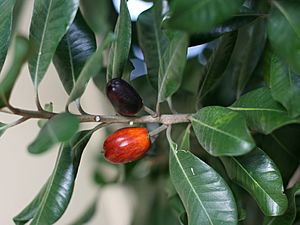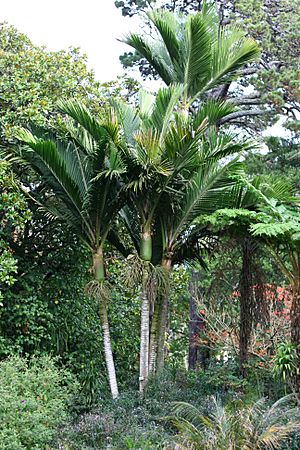List of vascular plants of Norfolk Island facts for kids
Norfolk Island is a special place with many different kinds of plants! This list tells you about the vascular plants that grow there. Vascular plants are like the "main" plants you see, with roots, stems, and leaves, including trees, flowers, ferns, and grasses.
Scientists studied the plants of Norfolk Island for a big book called the Flora of Australia in 1994. This list uses that information but updates it a bit. You'll learn about plants that are native to the island (called indigenous), and plants that were brought there by people and now grow wild (called naturalised). Some plants are even endemic, which means they are found only on Norfolk Island and nowhere else in the world!
Contents
Plants of Norfolk Island
Norfolk Island is home to 523 different types of vascular plants. Out of these, 136 are indigenous, meaning they grew there naturally. A much larger number, 387, are naturalised, meaning they were introduced by humans.
What's really cool is that 44 of the indigenous plants are endemic. This means they are unique to Norfolk Island! The island even has two plant groups (called genera) that are found only there: Ungeria and Streblorrhiza.
Flowering Plants: Eudicots
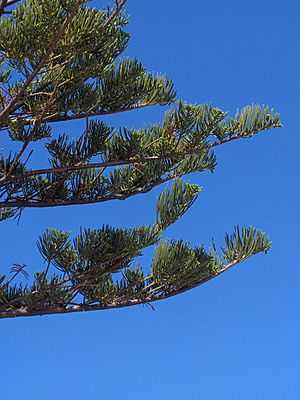
Eudicots are a large group of flowering plants. They usually have flower parts in groups of four or five, and their leaves often have veins that look like a net. On Norfolk Island, there are 75 families of eudicots, with 220 different groups (genera) and 287 species.
Some interesting eudicots you might find include:
- Acanthaceae: Hypoestes phyllostachya is a plant with pretty spotted leaves.
- Aizoaceae: Tetragonia tetragonioides, also known as New Zealand spinach, is a plant that can be eaten.
- Amaranthaceae: This family includes Achyranthes arborescens and Achyranthes margaretarum, both of which are endemic to Norfolk Island.
- Apocynaceae: The beautiful Alyxia gynopogon and Melodinus baueri are endemic plants from this family.
- Araliaceae: Meryta angustifolia and Meryta latifolia are two endemic trees found here.
- Asteraceae: This is a very big family, including many plants like Sonchus oleraceus (sow thistle) and Taraxacum officinale (dandelion), which are naturalised. Norfolk Island also has endemic species like Senecio evansianus.
- Convolvulaceae: This family includes the Calystegia affinis, which is endemic. You might also see the Calystegia soldanella (Beach Morning Glory) with its lovely pink flowers.
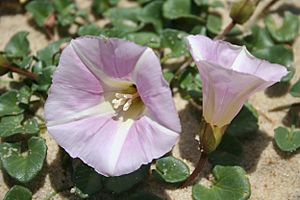
- Euphorbiaceae: The endemic Euphorbia norfolkiana is part of this diverse family.
- Fabaceae: This is the pea and bean family. A very special plant here is Streblorrhiza speciosa, which is endemic to Norfolk Island. Many naturalised plants like Lupinus cosentinii (lupin) and Trifolium campestre (clover) are also found.
- Malvaceae: This family includes the endemic Abutilon julianae and Hibiscus insularis. You can also find the beautiful Hibiscus tiliaceus (Beach Hibiscus) here.
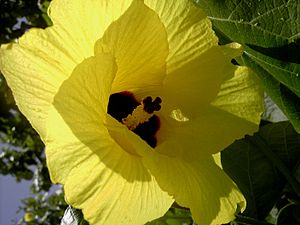
- Myoporaceae: The endemic Myoporum obscurum is a unique plant from this family.
- Pennantiaceae: Pennantia endlicheri is another endemic plant that grows only on Norfolk Island.
- Pittosporaceae: The endemic Pittosporum bracteolatum is a special tree from this family.
- Primulaceae: Rapanea ralstoniae is an endemic plant found in this group.
- Ranunculaceae: The endemic Clematis dubia is a climbing plant with pretty flowers.
- Rubiaceae: This family includes the endemic Coprosma baueri and Coprosma pilosa.
- Rutaceae: The endemic Melicope littoralis is a unique plant from this family, which also includes citrus fruits.
- Sapotaceae: Planchonella costata is a tree found on the island.
- Solanaceae: This family includes many well-known plants like tomatoes (Lycopersicon esculentum), which are naturalised. The endemic Solanum bauerianum is a special plant from this group.
- Urticaceae: The endemic Boehmeria australis subsp. australis and Elatostema montanum are unique to the island.
- Violaceae: The endemic Melicytus latifolius and Melicytus remiflorus subsp. oblongifolius are special plants from this family.
- Viscaceae: Korthalsella disticha is an endemic plant from this family.
Flowering Plants: Monocotyledons
Monocots are another big group of flowering plants. They usually have flower parts in groups of three, and their leaves often have parallel veins. On Norfolk Island, there are 16 families, 81 genera, and 110 species of monocots. Most of these are naturalised, especially grasses. Out of 43 indigenous species, 9 are endemic.
Some interesting monocots include:
- Agavaceae: Phormium tenax (New Zealand Flax) is a plant with long, tough leaves.
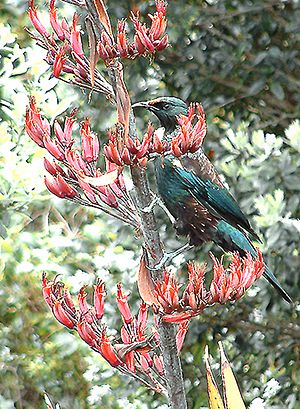
- Arecaceae: This is the palm family. Rhopalostylis baueri is a type of palm tree found on the island.
- Cyperaceae: This family includes sedges. The endemic Carex neesiana and Isolepis cernua var. setiformis are found here.
- Hemerocallidaceae: Dianella intermedia is an endemic plant from this family.
- Orchidaceae: This is the orchid family, known for its beautiful and unique flowers. Endemic orchids include Dendrobium brachypus, Dendrobium macropus subsp. macropus, and Phreatia limenophylax.
- Pandanaceae: Freycinetia baueriana is an endemic plant from this family, often called a screwpine.
- Poaceae: This is the grass family, with many naturalised species like Cynodon dactylon (Bermuda grass) and Lolium perenne (ryegrass).
Conifers (Pinophyta)
Conifers are trees or shrubs that usually have needles or scales instead of broad leaves, and they produce cones. On Norfolk Island, there are two species of conifers.
- Araucariaceae: The most famous conifer on the island is the Araucaria heterophylla, also known as the Norfolk Island Pine. This tall, majestic tree is endemic, meaning it grows naturally only on Norfolk Island.
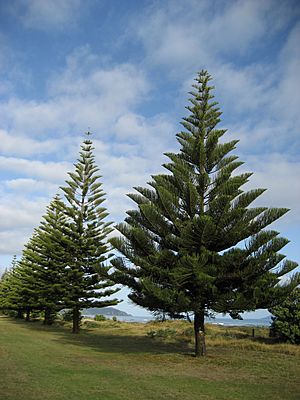
- Cupressaceae: Cupressus lusitanica (Mexican Cypress) is a naturalised conifer found here.
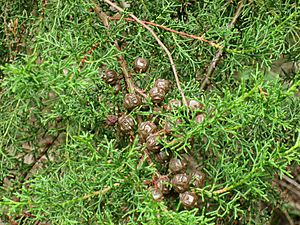
Ferns (Pteridophyta)
Ferns are ancient plants that reproduce using spores instead of seeds. They often have feathery leaves called fronds. Norfolk Island has 14 families of ferns, with 24 genera and 37 species. Seven of these fern species are endemic, and none are naturalised.
Some interesting ferns include:
- Aspleniaceae: Asplenium dimorphum is an endemic fern from this family.
- Cyatheaceae: This family includes tree ferns. Cyathea australis subsp. norfolkensis and Cyathea brownii are both endemic tree ferns unique to the island.
- Dryopteridaceae: Lastreopsis calantha is an endemic fern from this group.
- Hymenophyllaceae: Cephalomanes bauerianum is an endemic fern found here.
- Pteridaceae: Pteris kingiana and Pteris zahlbruckneriana are two endemic ferns from this family.
Clubmosses (Lycopodiophyta)
Clubmosses are small, ancient plants that look a bit like mosses but are more closely related to ferns. Norfolk Island has two species of clubmosses.
- Lycopodiaceae: Lycopodiella cernua is an indigenous clubmoss.
- Selaginellaceae: Selaginella kraussiana is a naturalised spikemoss.
Whisk Ferns (Psilotophyta)
Whisk ferns are unusual plants that don't have true roots or leaves. Norfolk Island has two species of whisk ferns.
- Psilotaceae: Tmesipteris norfolkensis is an endemic whisk fern, meaning it's found only on Norfolk Island.
Adder's Tongues (Ophioglossophyta)
Adder's tongues are small, simple ferns with a unique leaf structure. Norfolk Island has one species from this group.
- Ophioglossaceae: Ophioglossum petiolatum is found on the island.
Images for kids


